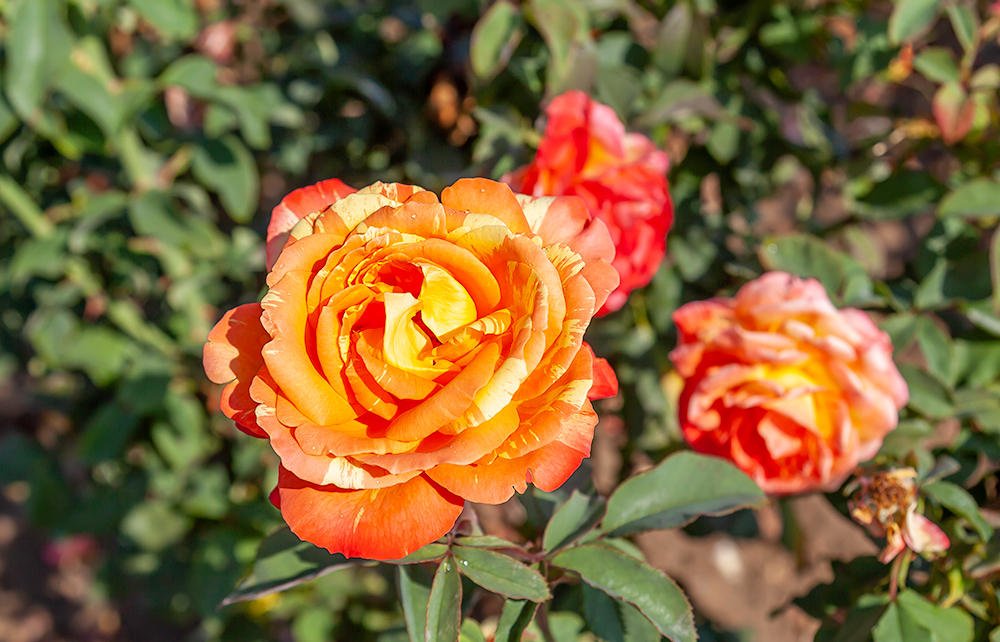Richard Sudell is the forgotten hero of the gardening revolution in Britain between the first and second world wars. A Quaker, born in Lancashire in 1892, the son of a straw and hay dealer, he left school at 14 and became a gardener, worked at Kew, then went to prison as a conscientious objector in 1916. On furlough from his first prison sentence, he worked with the Vacant Land Cultivation Society to help create allotments for London’s poor. When the first world war ended, he moved to Roehampton with his first wife. There he began writing a monthly gardening column in the Roehampton Estate Gazette advising his neighbours, most of whom had never had a garden before, on how to ‘beautify’ the debris-strewn patches of mud outside their new front and back doors. His columns were drawn together in his first book, The Town Gardening Handbook (1924), aimed at promoting horticulture throughout London County Council’s innovative housing estates.
‘Vegetable rats!’, Humphrey Brooke screamed at some neatly pruned yellow roses in a suburban front garden
A Sudell-inspired garden was structured, full of bright colour and labour-saving. It was not ‘a gardener’s garden’, where children, animals and games were taboo, but a small, practical space, easily maintained at weekends. Sudell recommended pyracantha, hanging baskets, manicured lawns, tea roses and pansies; he was also an advocate of crazy paving and suggested paths should be straight, so that washing could be dried alongside them. The estate tenants lived under permanent threat of eviction:
In those days if your garden was not up to scratch, the superintendent in his bowler hat, striped trousers and umbrella – the treatment – would knock on your door and give you a fortnight to put it right. If not, goodbye.
Michael Gilson’s Behind the Privet Hedge combines biography and social history to resurrect Sudell’s contribution to the ‘beautification’ of Britain. As secretary to the London Gardeners Guild, Sudell encouraged flower shows, lectures, competitions, communal ownership of garden tools and purchasing of discounted seeds and bulbs through the Guild. He started writing for Ideal Home in 1928 and moved to the Daily Herald in 1930, where his columns had a readership of two million. The English garden, Sudell opined, should be a space where the household could rest or read and ‘take their meals in the open air’. His book Landscape Gardening (1933) argued for extending the beautification project from behind the privet hedge to factories, hotels, golf courses, roadsides and petrol stations. On eBay it is still possible to buy a full set of Sudell’s 50 Wills cigarette cards providing practical advice on growing flowers from ageratum to zinnia.
The backlash against suburbia was vicious and immediate. ‘It is estimated that the combination of private and council house building between the wars contributed more than 200,000 hectares (500,000 acres) of new garden,’ Gilson writes. But many lamented or sneered at the vulgar taste of the suburban denizens: their ritualised visits to garden centres, the cheap furniture, water features and garden gnomes adorning their minuscule Edens. Edith Sitwell compared D.H. Lawrence to ‘a plaster gnome on a stone toadstool in some suburban garden’. Gilson notes the snobbery bursting from Sitwell’s ‘some suburban garden’ that she couldn’t be bothered to locate, and the irony of Lawrence’s own hatred for suburban houses, which he called ‘horrid little red rat traps’. Gilson points out that in the heated debate about whether suburbia was taking over Albion, the actual inhabitants of the new garden cities had no voice. Sudell spoke up for them.
Richard Mabey is at the opposite end of the gardening spectrum to Sudell. Best known as a nature writer since his first book Food for Free (1972), revered as the author of the plant bible Flora Britannica and other inspirational books, his many readers probably don’t think of him as a gardener at all – more an advocate for a new non-domineering understanding of the relationship between human beings and the rest of the natural world. His latest book, The Accidental Garden, is centred on the Norfolk garden that he and his wife Polly have curated over the past 20 years.
During the heatwave of 2022 Mabey and his wife ‘felt more vulnerable, less in charge of our own territory’. The odd feeling of gardening during a climate change emergency was exacerbated by perceptions of ageing and Mabey’s recent dependency on a stick ‘the natural world’s first tool… my Instrument of Minimum Intervention’. Accepting that their garden needed to adapt to the changing climate caused Mabey to reflect on their intentions when they moved into their house 20 years ago. ‘It feels disrespectful now how casually we treated our predecessors’ accoutrements, given we assumed without question that whatever we planned would last forever.’ In the garden they inherited was ‘an island bed plumped with azaleas and hebes’ that they condemned, along with the other cultivated beds ‘on which we quickly began delivering capital sentences’.
Towards the end of his meditative book is a chapter entitled ‘Rose-Tinted’, in which Mabey describes taking his friend Humphrey Brooke, an art historian, curator and renowned collector of shrub roses at Lime Kiln, to the local pub. On the way they passed a suburban front garden containing some neatly pruned yellow garden-centre roses, at which Brooke, to the astonishment of the deadheading proprietor, screamed: ‘Vegetable rats!’ Mabey comments:
It was a spectacular hissy-fit and a very odd epithet for a class of roses whose worst sin is maybe having a touch of bling. But I could see what he disliked in them – their waxen petals and brash colours, and an absence of what might be called the essence of rosaceousness – that wild, unkempt, headily perfumed fandango of crumpled silk petals and tangled thorn.
Wisely, Mabey acknowledges that, ‘the full saga of the rose dynasty is an epic narrative of social and cultural history’. The old roses he favours in his own garden are Fantin Latour, Willie Lobb, Omar Khayyam and the White Rose of York. Naturally he has no space for the shocking pink masses of Dorothy Perkins or the hybrid tea rose Mrs Sam McGredy. James Bartholomew’s Yew and Non-Yew (1998), extending Nancy Mitford’s ‘U and Non-U’ distinction to the horticultural world, remains relevant today. Marigolds and dahlias are Non-U, peonies are U, in case you need to know. Snobbery in the garden will never go away, even if we are all gardening against the apocalypse now.







Comments